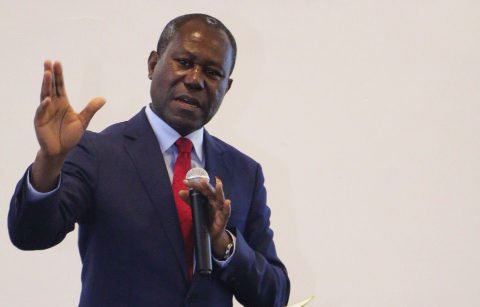- What is ‘Dreams on a Pillow’, the Palestinian game about the Nakba?
- Machinery behind bacterial nanowires discovered
- Students discover chimpanzees make rhythmic sounds (despite limited sense of rhythm)
- New fossil species sheds light on divergent life-history strategies in early land plants
- EU watchdog approves new vaccines against bluetongue
What do you believe is the single most important factor driving up the cost of living in Nigeria?
The banking institution and the larger story of sustainable development sweeping the African continent both consider Sterling Bank Headquarters' switch to solar energy to be a turning point. Embarked solely on solar energy, Sterling Towers, a Landmark Building in Marina, Lagos State, is today a shining example of environmental responsibility and creativity. With this significant change, Sterling Bank is demonstrating its unwavering commitment to lessening its environmental impact and leading the way in the region's adoption of renewable energy solutions.
A deep understanding of the relationship between environmental sustainability and economic prosperity is at the core of this shift. Sterling Bank's adoption of solar electricity is more than just a calculated move; it signifies a fundamental change in the company's principles that place a higher priority on social responsibility and sustainability. By using solar power to meet its energy needs, the bank lessens its dependency on finite fossil fuels and establishes a new benchmark for business sustainability in Africa.
The banking institution has produced a statement articulating the significance of this change with conviction and clarity. Sterling Bank's decision to use solar energy to power its iconic offices demonstrates its commitment to minimizing its environmental effect while promoting economic growth. This choice not only reflects the bank's dedication to ethical business practices but also acts as a spur for improvement both inside and outside the financial sector.
The program has the potential to be transformative, as noted by Ibidapo Martins, the Group Chief Marketing Officer at Sterling, who claims that it marks a paradigm shift in how organisations handle environmental management and energy use. In addition to showcasing its leadership in sustainability and innovation, Sterling Bank's investment in solar infrastructure places it as a pioneer in the shift to a low-carbon economy. The bank's reputation is enhanced by this progressive attitude, which also creates new opportunities for growth and cooperation in the rapidly expanding renewable energy industry.

The solar integration project at Sterling Bank has far-reaching effects outside of the company's main office. Serving as the largest solar project in Africa to date, Sterling Towers has around 3,250 high-efficiency crystalline silicon photovoltaic glass panels covering 6,500 square meters. Through this enormous project, the bank can demonstrate its technological expertise and the enormous potential for renewable energy adoption throughout the continent. The effective use of solar energy at Sterling Towers, sends a strong message to other companies and decision-makers, demonstrating that sustainable growth is both technically and financially feasible.
Martins goes into more detail about the project's size and breadth while highlighting its long-term advantages on Sterling Bank and the community at large. As it reduces greenhouse gas emissions and lessens the effects of climate change, Sterling Towers is positioned to become a net contributor to the local energy grid, with an expected output of 10,500 MWh over the next 25 years. Furthermore, the bank will further strengthen its competitive edge and long-term sustainability by reinvesting the financial savings from the switch to solar energy into customer-centric products and services.
With an eye on the future, Sterling Bank is unwavering in its dedication to promoting corporate responsibility and environmental care. The bank is always looking for new and creative ways to incorporate sustainability into its core business operations, from encouraging sustainable lending practices to putting energy-efficient building designs into practice. Initiatives like Sterling Bank's solar integration project serve as rays of hope as the world struggles to address the pressing issues brought on by climate change. They show that meaningful action is achievable and that by working together, we can create a better, more sustainable future for future generations.
Sterling Bank's move to solar energy has wider ramifications for Nigeria and the continent as a whole, in addition to the obvious advantages of cutting carbon emissions and energy expenses. Nigeria, with the largest economy in Africa, is a major force in determining the energy landscape of the continent. The nation can lessen its reliance on fossil fuels, lessen the effects of climate change, and seize new chances for economic growth and development by embracing renewable energy sources like solar power.
Furthermore, Sterling Towers' switch to solar power is evidence of the bank's dedication to promoting constructive community change. Sterling Bank enhances its sustainability and improves the general well-being of its communities by investing in clean energy solutions and minimizing its environmental impact. This all-encompassing approach to corporate citizenship highlights the bank's commitment to generating shared value and long-term prosperity for all parties involved.
As long as Sterling Bank is setting the standard for sustainable growth, other companies and organizations are encouraged to do the same. By proving that environmental preservation and economic growth are complementing goals rather than antagonistic ones, Sterling Bank establishes a model for other banks to follow. We can steer towards a more sustainable future that is based on fairness and inclusivity, powered by clean energy, and stewarded responsibly by working together, ingenuity, and group effort.
The move of Sterling Bank Headquarters to solar power is a significant step toward a more just and sustainable future. In addition to lessening its environmental effect, Sterling Bank establishes a new benchmark for corporate responsibility and leadership by using solar energy to meet its energy needs. Initiatives like this one serve as a reminder of the transformational power of group action and the limitless potential of human creativity to address the issues of our time, particularly as we stand on the brink of a historic moment. By working together, we can create a future where sustainability and prosperity go hand in hand, and where the welfare of present and future generations is protected for many years to come.
Africa, with its abundant sunlight and growing energy demands, is ripe for a renewable energy revolution. As the continent grapples with economic growth, urbanization, and climate change, forward-thinking institutions like Sterling Bank recognize the need to balance progress with environmental stewardship. The move toward solar energy aligns with the United Nations’ Sustainable Development Goals, emphasizing clean energy access, climate action, and responsible consumption.
A Solar Marvel
• Architectural Brilliance
Sterling Towers, an architectural marvel, now draws power from the sun. Its sleek glass façade reflects not only the Lagos skyline but also the bank’s commitment to sustainability. The rooftop solar panels, strategically positioned to capture maximum sunlight, silently convert photons into electricity. The building’s design seamlessly integrates form and function, demonstrating that aesthetics need not be sacrificed for eco-consciousness.
• Energy Independence
By relying solely on solar energy, Sterling Bank has achieved a remarkable feat: energy independence. Gone are the days of fossil fuel dependency and grid fluctuations. The Towers now generate their electricity, reducing strain on the national grid and contributing to a more stable energy supply. This autonomy empowers Sterling Bank to operate efficiently while minimizing its carbon footprint.
• Inspiring Others
Sterling Towers serves as a visible testament to what’s possible. Other corporations, both within and beyond the financial sector, take note. The ripple effect extends beyond Lagos—across Nigeria and neighboring countries. CEOs and boardrooms engage in discussions about replicating this model, sparking a broader conversation about sustainable practices. Sterling Bank’s bold move inspires others to reimagine their energy sources and embrace renewables.
The Triple Bottom Line: People, Planet, Profit
• Social Responsibility
Sterling Bank’s commitment to social responsibility goes beyond shareholder value. It recognizes that its actions impact communities, employees, and customers. By investing in solar energy, the bank contributes to cleaner air, healthier neighborhoods, and a better quality of life for Lagosians. Employees take pride in working for an institution that prioritizes their well-being and the well-being of future generations.
• Environmental Stewardship
Solar energy reduces greenhouse gas emissions, mitigating climate change. Sterling Bank’s decision aligns with global efforts to limit global warming and protect vulnerable ecosystems. The bank’s carbon footprint shrinks, and it becomes a role model for sustainable business practices. As other companies follow suit, the collective impact on the environment grows exponentially.
• Economic Viability
Critics argue that sustainability comes at a cost. Sterling Bank defies this notion. Its solar investment pays dividends over time. Reduced energy bills, tax incentives, and positive brand perception contribute to long-term profitability. The bank’s foresight positions it as a resilient player in a changing energy landscape. Investors recognize that sustainability isn’t a trade-off; it’s a strategic advantage.
Sterling Bank’s switch to solar energy isn’t just about kilowatts and panels; it’s about rewriting the narrative of African development. As the sun bathes Sterling Towers in golden light, it illuminates a path toward a greener, more prosperous future. The bank’s leadership inspires us all to think beyond profit margins—to consider the legacy we leave for generations to come. Sterling Bank’s journey isn’t merely a turning point; it’s a beacon guiding Africa toward sustainable progress.






















